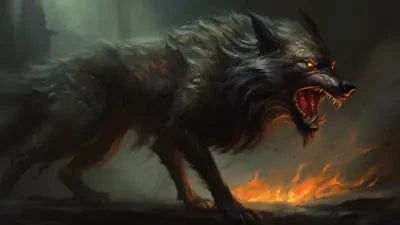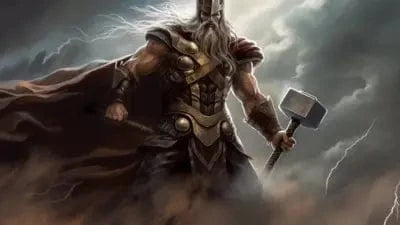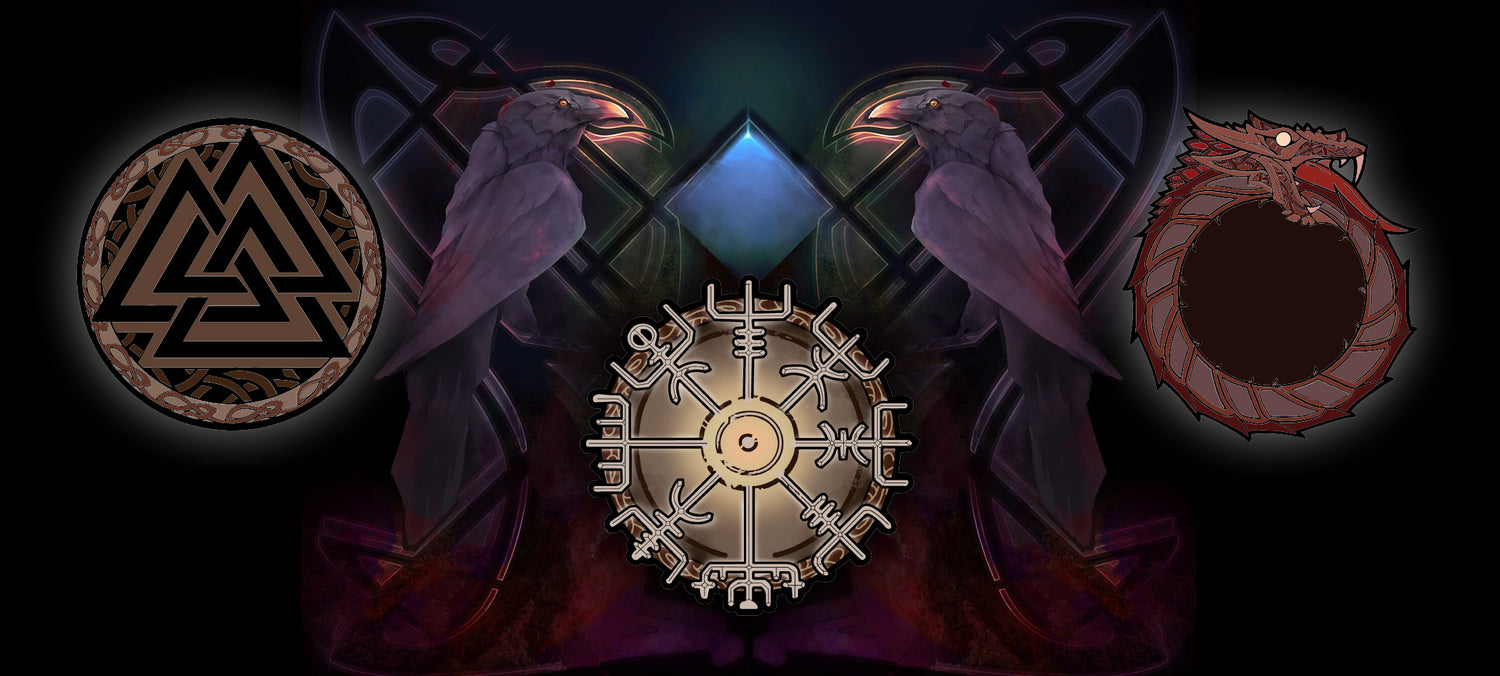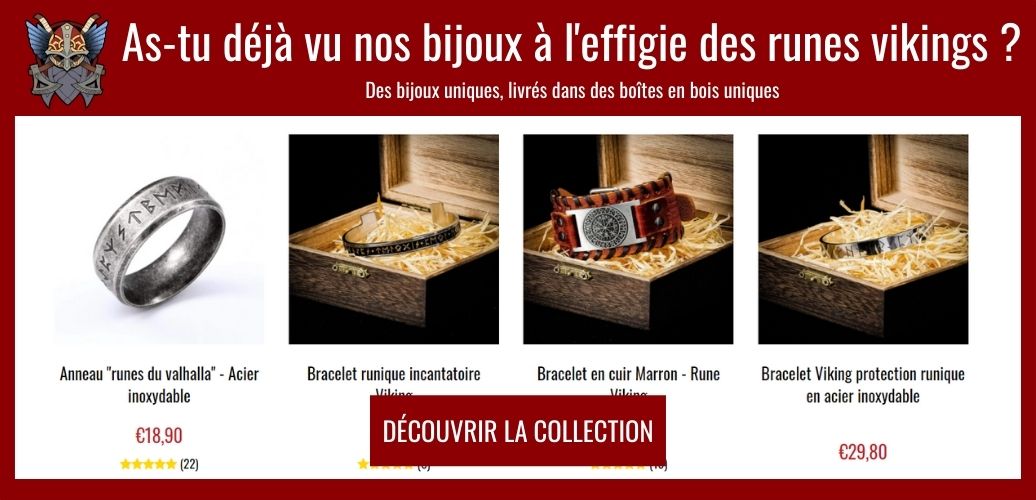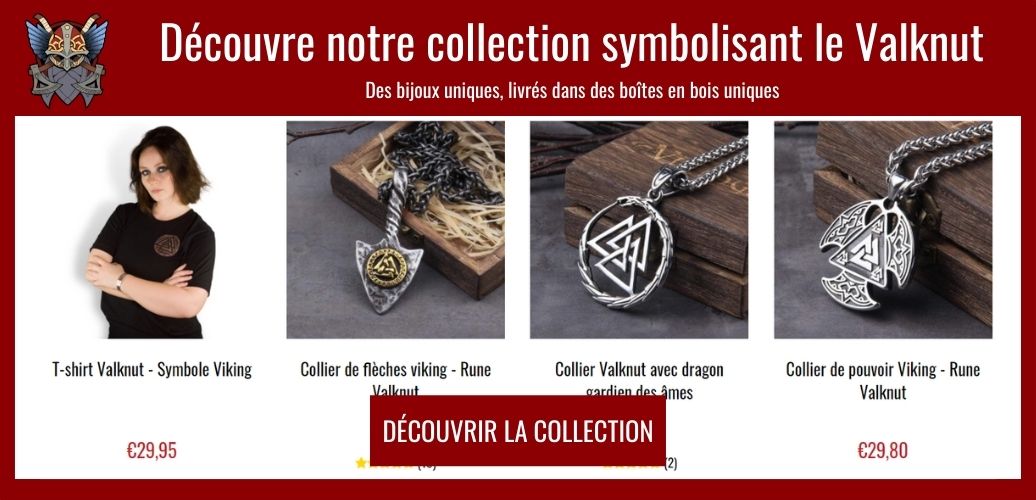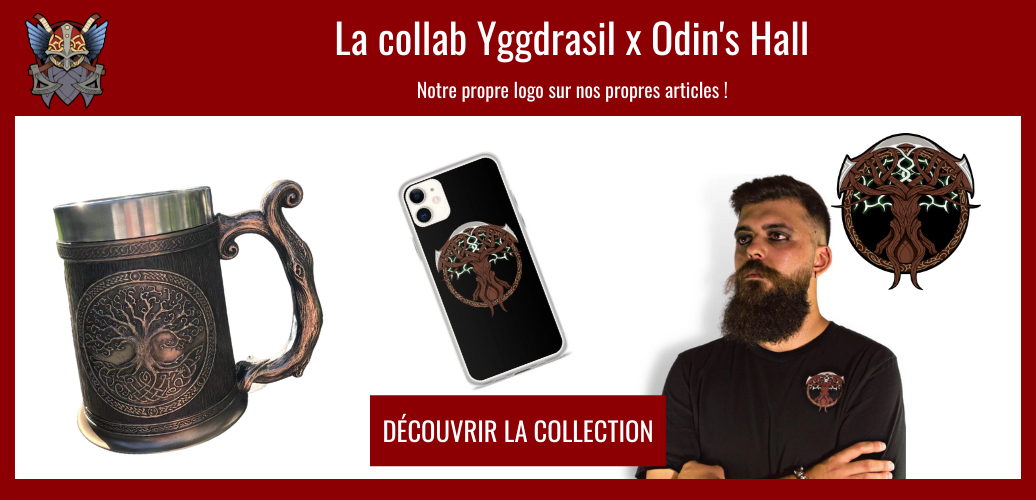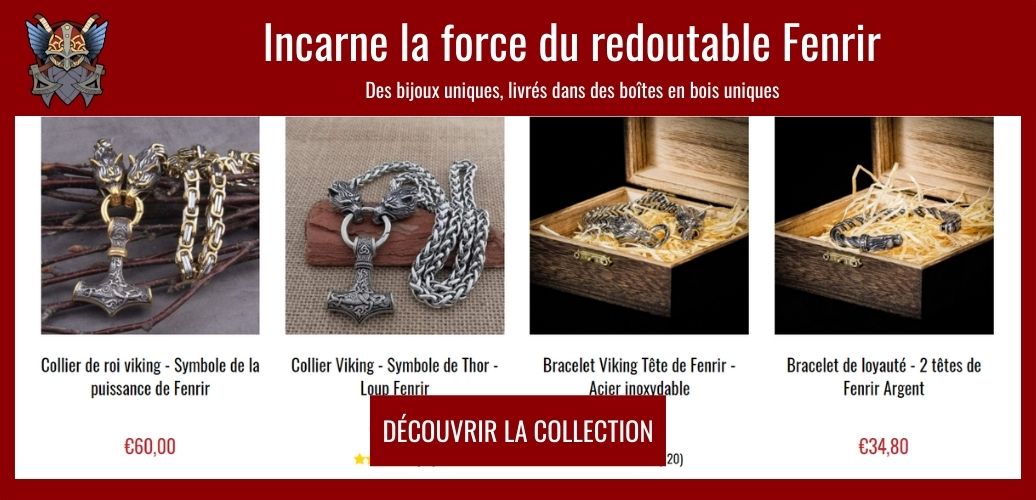Hello, my brothers and sisters Vikings! Many of you have purchased Viking items with Norse symbols in our "Odin's Hall" shop, but do you know their meaning and origin?
In this article, we will shed light on themost famous mythological symbols today and tell you a little more about their meaning. Any true fan of the Viking culture loves to wear clothes and accessories with tattoos and symbols from Norse mythology. However, it is important to know the meaning of the symbol you are wearing, especially when some of these symbols are taken up by other modern movements.
After reading this article, you will be able to choose your Viking jewellery and clothing not only based on the appearance of the items you like, but also on their meaning.
Here we go!
The importance of Viking symbols in their daily lives
The Vikings saw Norse symbols as a link tofate and spirituality, the two things that were sacred to any Viking. Having fate on their side could make the difference between life and death, and there is no need to waste words to emphasise the importance of the gods of Norse mythology in Viking times.
These are the two reasons why Norse symbols feature so prominently in Viking culture, and why almost every Viking jewel was associated with one of these symbols.
As the Vikings sincerely believed that symbols held power, it is not surprising that they wanted to have them at hand in case of danger or uncertainty. They lived in heat, cold, wind and rain. They sailed the high seas, fought countless battles, and they needed to believe that fate and the gods were on their side.
That's why the Vikings carved these divine symbols into their jewellery, painted them on their shields, sewed them onto their clothes and carved them onto their longships.
All because they felt that fate and their gods were on their side.
Today we will discuss the following symbols:
- Nordic runes,
- Mjolnir,
- Valknut,
- the helmet of terror,
- Vegvisir,
- Triskele
- Viking axe,
- Yggdrasil,
- Gungnir,
- Web of Wyrd,
- Swastika,
- Svefnthorn,
- The Troll's Cross,
- The long boat,
- The ravens of Odin,
- Boars and Cats,
- Bears,
- Wolves,
- Dragons.
If the symbol you are looking for is not here, then you can check our other blog posts, it is possible that we have covered it separately.
And now, without further ado, let us begin our story.

44,90€
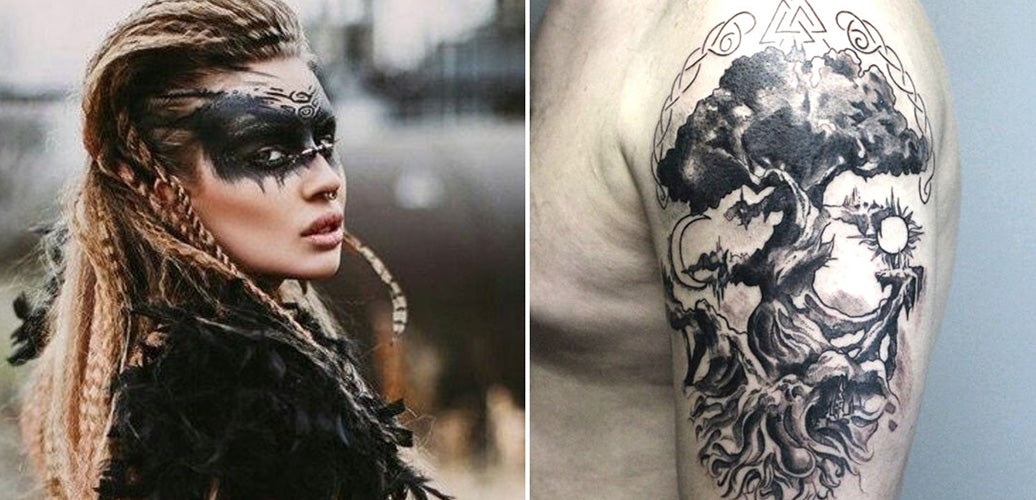
On these illustrations from Pinterest, you can see on the left a woman with Norse mythology-inspired clothing and markings and on the right a man with the Yggdrasil symbol tattoo.
NORDIAN RUNES, A VIKING ALPHABET
The word rune has its origin in the Old English word run (Old Norse runir), which means "a mystery or secret". Therefore, it is not surprising that runes were only used to convey special and extraordinary messages. Some Vikings even believed that runes possessed special powers.
Runes are very similar to letters, with one exception. In addition to being related to specific phonetic sounds, runes also have individual meanings, like glyphs in other ancient cultures. The Norse runic alphabets are named after the first six runes F, U, TH, A, R, K - the futharks. Historians have found that the earliest known futhark dates back to the period between the 2nd and 4th centuries.
As mentioned earlier, the Vikings only used runes in extraordinary situations. They did not use parchment to write down their stories, but passed them on orally from one generation to the next.
They did not use these divine symbols for just anything, but when runes were used, they were carved only in wood or stone. This is why most of the stories about the lives of the most famous Vikings have been found engraved in rune stones.
As the Vikings believed that runes had magical powers, it was common to engrave them onjewellery, shields and beads. They believed that these symbols would protect them and grant them victories in battle.
Nordic mythology tells us that runes are not created by men, but are part of their divine world. They are as old as Yggdrasil, the tree of life, and are engraved on its trunk. The runes had such power that even Odin, the god of gods, was willing to suffer much to understand them. (Although that is a whole other myth)
Now back to our story.
These early runes are known as the Ancient Futhark and were used by manyNordicandGermanic tribes until the very beginning of the Viking Age. It was then that the Young Futhark slowly began to take its place. The Young Futhark had fewer runes (16 in total). However, as the transition was rather slow, the runes of the Old Futhark that were no longer used continued to be used as glyphs.
Today, twelve centuries later, we can still interpret the Elder Futhark. In fact, most modern Viking jewellery uses this version of the runic alphabet, as it has more letters than the younger Futhark.
You can see this by looking at the jewellery we offer on Odin's Hall.
If you want to learn how to master the runes, check out the YouTube channel "Initiation to Runes"
MJÖLNIR - NORDIC SYMBOL OF THUNDER AND FIRE
Let's start our list with the most important (and most popular) of all the Norse symbols: Thor's Hammer, or Mjölnir (Old Norse Mjǫllnir).
In fact, you can check out our article on Thor, the god of thunder and son of Odin.
The origins of the word Mjolnir are a bit unclear, as various sources suggest different things. Let's take a look:
One source suggests that it means "white", symbolising the colour of lightning, while others say it means "lightning". Other sources say that Mjölnir means "fresh snow", symbolising the purity of the soul. Finally, some sources link Mjolnir to words such as "crush" or "grind."Surely because of the power of the thing!"
Let's forget for the moment the meanings we mentioned above and take a look at what the real Vikings believed at the time. When a Viking heard thunder or saw lightning, he believed that Thor had used his powerful hammer to strike down another giant.
However, let us not forget that Mjölnir was much more than just a divine weapon. Thor used his hammer for various purposes, including blessing people and things. For example, Thor used his hammer to bless newlywed couples to ensure that they would have numerous offspring.
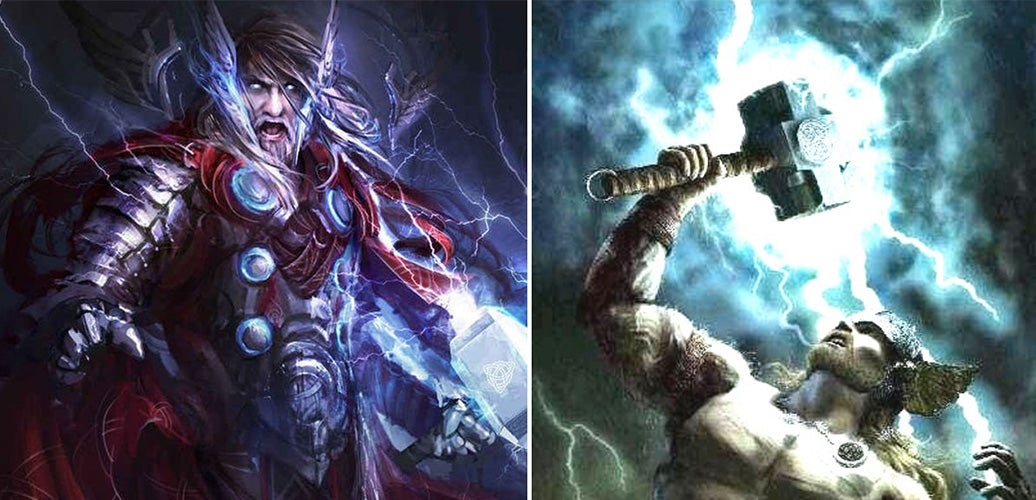
Snorri Sturluson described how Mjolnir was created in the second part of the Eda Prose, Skáldskaparmál. In short, Loki won a bet with the dwarves Sindri and Brokkr, and as a result, the dwarves madethe most powerful of all hammers - Mjolnir.
In addition to being associated with thunder and lightning, the Scandinavians believed that Mjolnir was also a symbol of safety and protection. Here's why:
As mentioned earlier, Thor used his hammer to bless people and to kill giants, thus protecting them. It is therefore quite understandable why the Vikings thought that Mjölnir was a symbol ofprotection and safety. Furthermore, this symbol is considered one of the most powerful warrior symbols of the Viking Age.
Archaeologists have discovered hundreds of Mjölnir amulets in various Norse archaeological sites and Viking tombs. The symbol was so important in Viking culture that Vikings continued to wear Mjölnir pendants with crosses even after they converted to Christianity.
Don't forget to check out our wide selection of items featuring Mjolnir.
To find out a little more and have the chance to listen to Nota Bene's sweet voice, we invite you to watch this video:
VALKNUT - NORDIAN SYMBOL OF FALLEN HEROES
Known as the knot of Odin, Valknut is undoubtedly one of the most famous symbols of Norse mythology. The word "valknut" comes from the words valr (meaning slain warrior) and knut (meaning knot).
As Odin was the one who welcomed heroes killed in battle to Valhalla, many Viking tombs contained figurines related to Odin with the symbol of Valknut drawn right next to them. Thus Valknut became the symbol of Odin.
Of course, Valknut has a deeper meaning. The symbol consists of three triangles with nine corners. What can these corners mean? The answer is very simple. Each corner is associated with one of the nine worlds of the Nordic universe. In addition, this symbol also represents the cycle of life through pregnancy and motherhood.
To discover some of our items bearing the Valknut symbol this goes to link.
THE HEAVEN OF TERROR (ÆGISHJÁLMR ) NORDIAN SYMBOL OF PROTECTION AND VICTORY
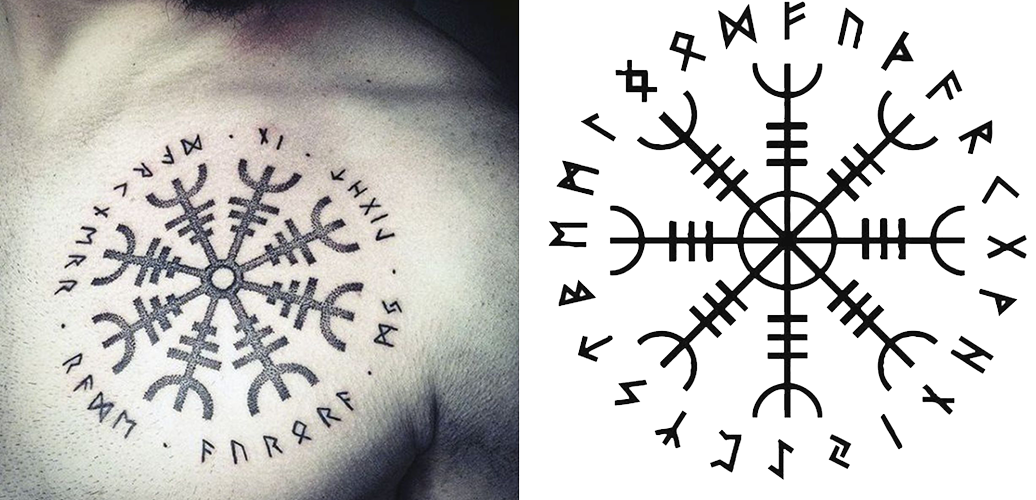
The heaven of terror or fear (in Old Norse Ægishjálmr) is a Norse divine symbol of protection and victory. Several sagas (including Galdrabók) mention that it was used not only by Viking warriors but also by dragons (which seems hard to believe, no?!). Nevertheless, Volsunga says that Sigurd took it after killing the dragon Fafnir.
As for the modern description of Ægishjálmr, it varies, and here's why:
Some sources say that Ægishjálmr is a magical object, while others describe it as an invisible sphere of protection that inspires fear in nearby enemies. One thing all sources have in common is that it was a magical symbol.
The eight linear shapes extending from the centre of the symbol represent the space between the eyes. Each shape consists of the rune of protection and victory (rune Algiz) interspersed with runes of hardening (rune Isa).
So, the deeper meaning of the symbol of the helmet of fear could be to defeat all obstacles that fate places in your path through the hardening of your soul and spirit.
VIEW - VIKING HOOD SYMBOL
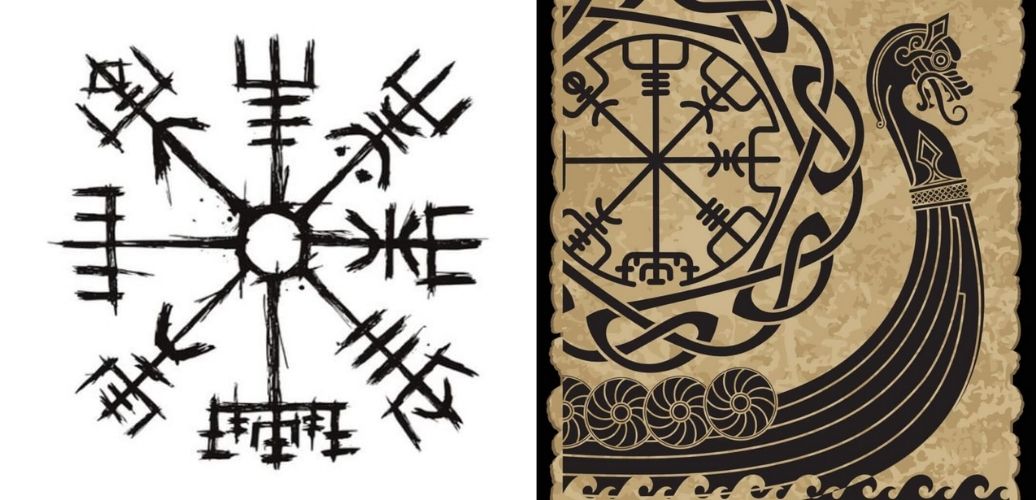
The name of this symbol, Vegvisir, comes from the words "vegur" (meaning path) and "visir" (meaning pointer), and means "scout". Vegvisir is very similar to Ægishjálmr, so many people think they are one and the same. Like the Helm of Awe, Vegvisir consists of eight 'beams' that meet in the centre. The only difference is that all the beams of Vegvisir are different, whereas Ægishjálmr has eight completely identical beams.
Vegvisir was one of the most powerful Norse symbols, and here's why.
The Vikings believed that this symbol had the power to show the right path to those who had gone astray. And yes, they had ways to help them find the desired direction, such as sunstones, but everyone felt at ease if they were in possession of a magical symbol as powerful as the Vegvisir.
Can you imagine the value of this kind of artefact in Viking times?
This symbol was of immense value as the Vikings often sailed into the unknown, and having this special tool by their side to guide them was invaluable. This is why mostViking ships were "decorated" with the Vegvisir symbol.
To see some of our items with the Vegvisir symbol, click here
THE TRISKEL ODIN HORN SYMBOL
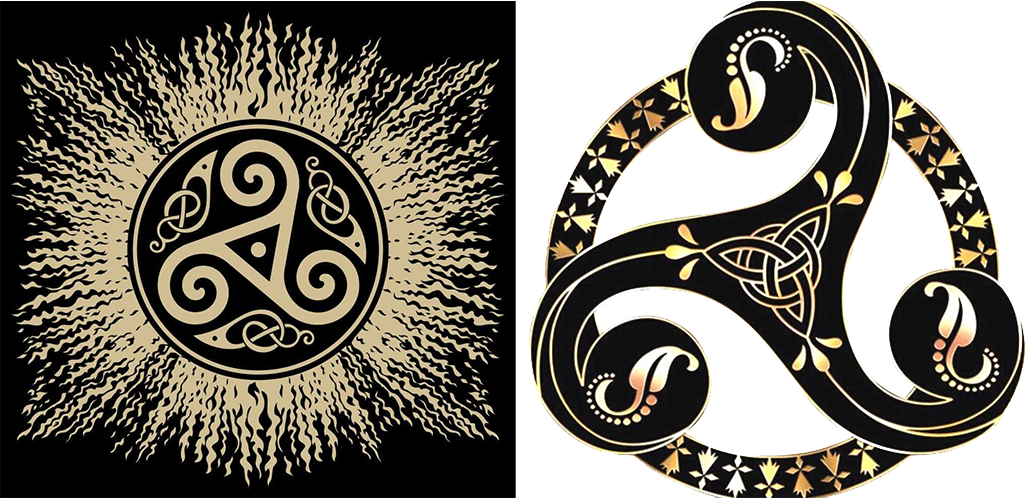
The symbol of the Triskele (also known as the Horns of Odin) consists of three connected drinking horns. The meaning of the Triskele is still somewhat unclear. The most common belief is that it tells the story of how Odin stole the mead of poetry. The drinking horns are called Boðn, Óðrœrir and Són. This symbol has a unique value for all those who worshipped Odin.
The two oldest discoveries of the Triskele symbol date back to the 8th or 9th century. The oldest discovery is in Sweden, on the Larbro stone, and it is believed that these discoveries date back to the 8th century. The other discovery of this rune is related to the 9th century Snoldelev stone (found in Denmark).
In modern culture, this symbol is often worn by artists and writers seeking inspiration, due to its connection with the artistic virtues of Odin and the Mead of poetry.
The VIKING HORSE - A NORDIAN SYMBOL OF BRAVOUR AND STRENGTH
The Viking axe was the most used and famous of all Viking weapons. They were built in different sizes, from one-handed battle axes to two-handed battle axes. Many battle axes had a hook-shaped lower part of the blade that allowed warriors to pull the shields and limbs of their enemies with ease.

If you're wondering why Vikings preferred axes to swords, here's the answer:
Making an axe required far less time and iron (not to mention skill) than making a sword. In addition, each farm had to use an axe to cut wood every day. For these reasons, the Vikings practically grew up using axes, which made them one of the most feared warriors. Even long after the end of the Viking era, the descendants of the Vikings remained famous for their skill with the axe.
The axe symbol represents strength and bravery. Its deeper meaning can be interpreted as the ability of a person's heart or spirit to overcome all obstacles on their life path.
YGGDRASIL - THE TREE OF LIFE

Yggdrasil is a vast mythical tree that grows in the middle of the cosmos and connects the nine realms of the Nordic universe to each other. The tree grows from the well of Urd and symbolises the creation of life from water, which is why it is called the tree of life.
Yggdrasil is one of the main Nordic symbols that indicates the mutual connection of all things in the Nordic universe. But we will come back to its deeper meaning a little later.
Yggdrasil plays a crucial role in Norse mythology, and here are some reasons why:
For starters, the gods preserved their youth by consuming Yggdrasil fruit. Furthermore, the tree of life plays a vital role in preserving the Norse universe after Ragnarok. According to a myth, a man and a woman will hide under its trunk and survive the final battle, after which they will populate the world again. Another important part of Norse history is linked to Yggdrasil. It is a place where Odin hanged himself during his quest for wisdom.
The symbol of Yggdrasil has also been used by many ancient civilisations to symbolise the connection of all things in the universe.
For the Vikings, it represented the cycle of life, the cosmos, a link between fate and time, and above all, harmony.
All in all, this symbol is certainly not just another Norse symbol, it is one of the most influential symbols of the Norse faith.
GUNGNIR - THE ODIN LANCE
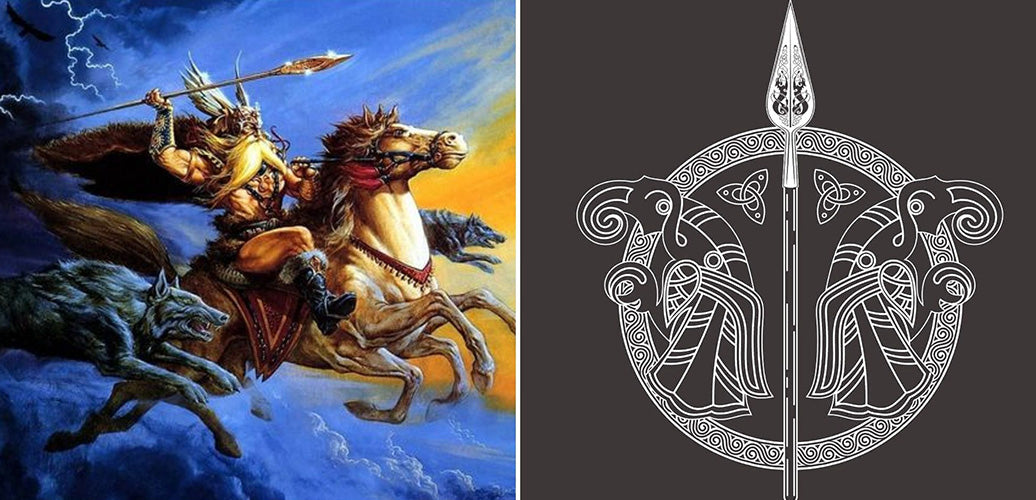
The spear of Odin, Gungnir, is a symbol closely associated with Odin. It was made by the best of Dwarven craftsmen, who also created Skidbladnir, Freyr's ship, and the golden thread of Sif's (Thor's wife) hair.
Gungnir is a powerful artifact inscribed in magical runes, so that it will never miss its mark. It is quite extraordinary, but what else can you expect from a weapon wielded by the god of gods himself!
This symbol had various uses in Viking times. Here are some of the most common:
During his quest for wisdom, Odin had to stab himself with Gungnir and suspend himself at Yggdrasil for nine days before the runes revealed themselves to him. This is why the Vikings used spears to stab and hang their sacrifices to Odin.
Another interesting thing related to the Gungnir symbol is that the Vikings would throw their spears over the heads of their enemies shouting "Óðinn á yðr alla! ("You all belong to Odin"). They hoped to gain Odin's favour and win the battle.
But what does this have to do with Odin, you may ask?
Well, during the Aesir-Vanir war, Odin threw Gungnir over the heads of the Vanir gods, shouting "You are all mine!". Now you get the idea...
To summarise, in Norse mythology, Gungnir is a symbol linked to Odin. It represents inspiration, skill, courage, precision, strength, concentration and wisdom.
WYRD STAR - SYMBOL OF THE PAST, PRESENT AND FUTURE
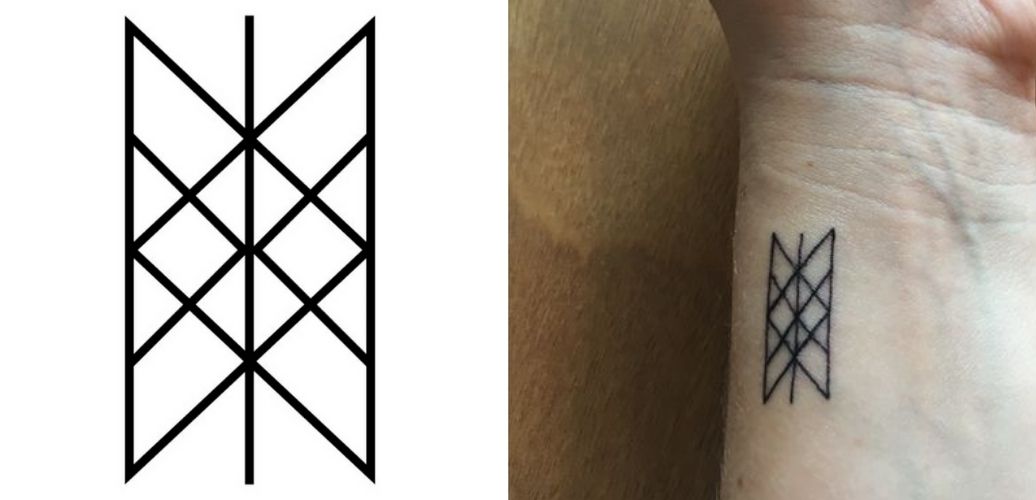
The Vikings believed in many things, one of which was that no one can escape their fate, not even the Gods. The idea of fate was so fundamental at the time that the Scandinavians used six different words for it. This deep-seated belief that the outcome of every situation in life was already determined is something that gave the Vikings their legendary courage.
In Norse mythology, the beings who shape fate are called the Norns. They live under the world tree and guard the well of Urd (fate). It is there that the Norns weave the magical tapestry of the web, which will determine the fate of all beings.
The Wyrd's Web symbolises the tapestry. There is no written evidence that this symbol was used in Viking times. The symbol consists of nine intersecting lines, and within these all the runes can be seen.
As the runes resided in the Well of Urd and had the power to show the past, the present and future, it was believed that when a person looked at the symbol of the Wyrd's Web, he or she could also glimpse the past, present and future.
SVASTIKA - A SYMBOL OF LUCK AND HOLINESS
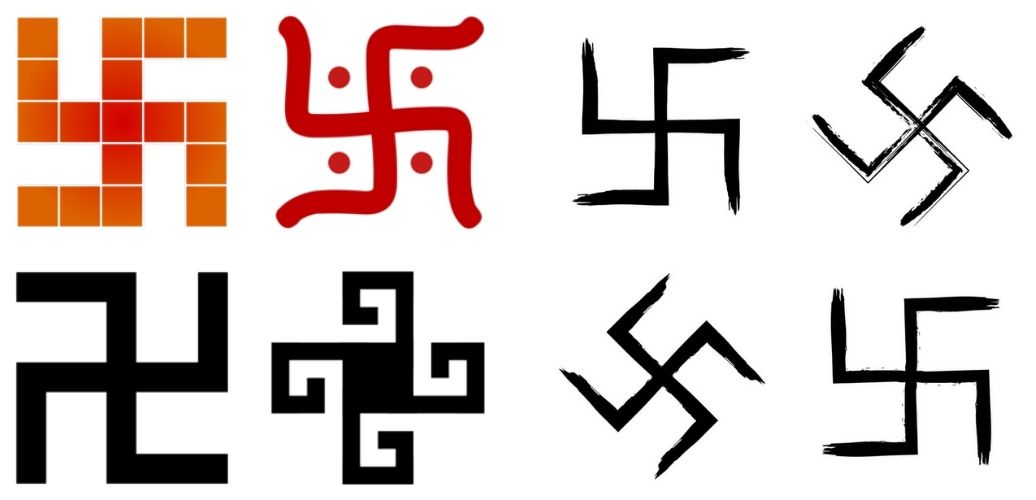
What is the first thing that comes to mind when you think of the swastika? Of course, the Second World War and Nazi Germany. Yet the symbol was created centuries ago and was often associated with sanctity, continuity, power and luck. It appears in the iconography of several ancient civilizations.
In the Norse religion, its significance was linked to Thor. The swastika was often engraved on objects to bring luck and sanctity to their owners.
Many symbols from Norse mythology have been taken up in different movements, giving them new meaning. I'll let you listen to this video which explains it very well.
SVEFNTHORN
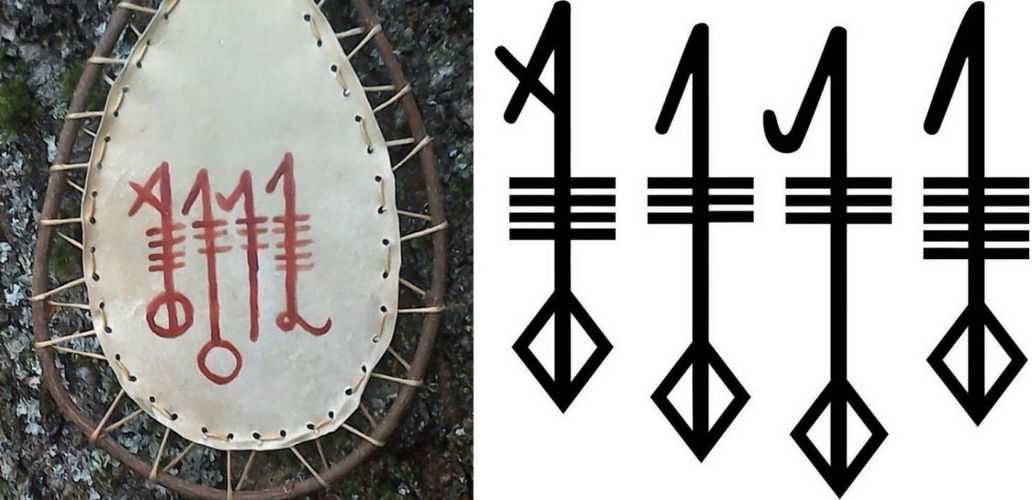
The Svefnthorn is one of the Norse symbols that is mentioned quite often in the Viking sagas, such as the Volsunga saga, the King Hrolf Kraki saga, and the Gongu-Hrolfs saga.
Most of the magical properties of this symbol were different in each myth, except for one. The only power that Svefnthorn possessed (in all tales) was his ability to sleep enemies. For example, Odin used Svefnthorn to put Brunhild (Valkyrie) to sleep.
The TROLL CROSS - NORDIAN SYMBOL OF PROTECTION
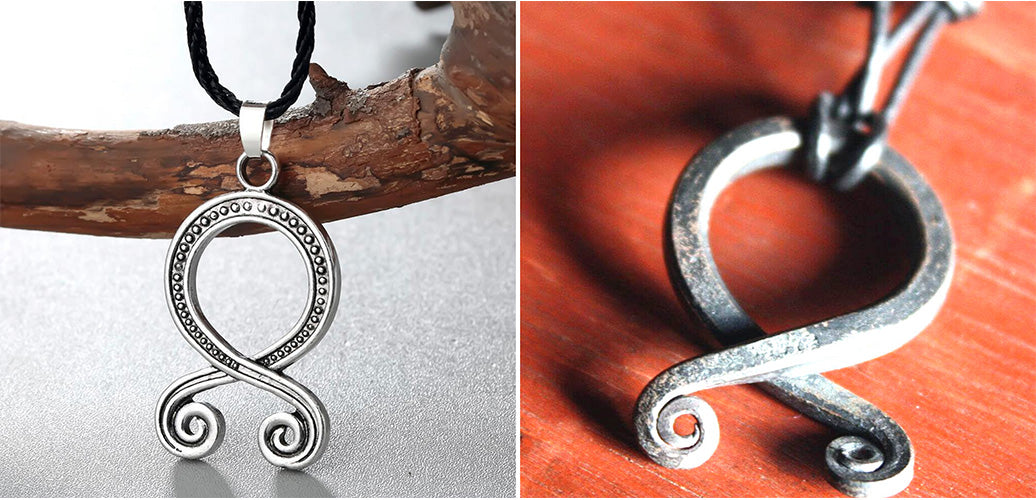
This symbol is originating in Sweden and was carved in the form of the rune Othala. The troll cross was a magical amulet that protected the wearer from trolls and black magic.
The Vikings believed that wearing this symbol diminished the chances of encountering danger on their way. It is considered a symbol of protection.
DRAKKARS - NORTHERN SYMBOL OF VIKING MENTALITY
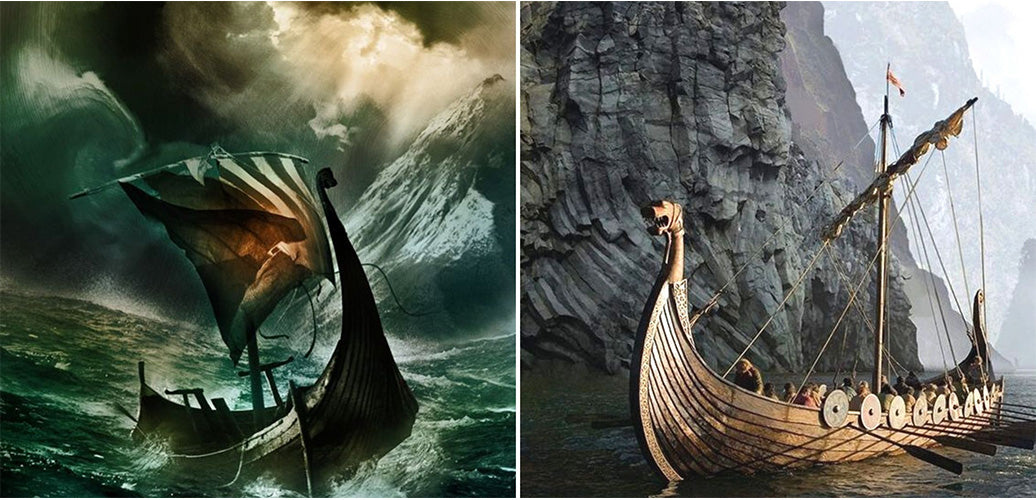
We all agree that the Vikings were great and fearless warriors. However, they had an additional asset that gave them a considerable advantage over their enemies: theirdrakes.
The unique design of their ships was ahead of its time. With its incredibly shallow draft, the manoeuvrability of Viking longships was unrivalled. This is precisely what made the Vikings so superior in terms of mobility and military dominance. They were able to use the same ships to navigate the ocean and use the rivers to navigate inland, practically knocking on the enemy's doors.
Do you know who else was able to do that in the 8th century? Well, no one.
Besides the advantages mentioned above, the longships were made for speed. They could use thepower of the wind to sail, or row with oars if the wind was not in their favour.
With their longships, the Vikings had an element of surprise on most occasions. As there are records of Vikings sailing to England, Iceland, the Mediterranean, and even Greenland and North America, you can imagine how unprepared their enemies were for the battles ahead. It took a long time for even the most powerful countries in Europe to adapt and defend themselves against Viking attacks.
The Vikings' longships are also known as "dragon ships". This is not surprising, as they wreaked unseen destruction at the time, and most of them had bows carved in the shape of a dragon's head.
The Skíðblaðnir and the Nalgfar are the two most powerful ships in the Norse universe. The Skíðblaðnir was a magical ship that belonged to the god Freyr. It was big enough to carry all the Asgardian gods. They used it quite often on their journeys by sea, land and even in the air. The ship was built by the best dwarven craftsmen so that it could be folded to fit in the owner's pocket. A magical ship, indeed!
The other ship, Naglfar (Old Norse for "nail farer"), was built with the nails of the dead! And who could possess this ship if not Hel, the goddess of death herself! There is a prophecy about this ship that when Ragnarok comes, it will carry Loki and his army of giants to attack Asgard.
Let's get back to the "real" Viking ships.
Let's get one thing straight. Drakkars were not "real ships" as we might imagine them today. They were simply larger ships, whose "marines" were fully exposed to wind, cold and heat. The Vikings were able to touch the water with their own hands by simply ducking down!
And these were the types of boats that the Vikings used to cross the ocean! Can you imagine that?
This kind of commitment, courage and desire to venture into the unknown can only be understood by true Vikings. We, who are in love with their heritage, can only try to imagine it, and dream of being there on one of those magnificent longships.
So what do these longships symbolise?
Nothing less than the Vikings alone and everything about them. Their mentality in general.
Discover the Drakkar T-shirt Odin's Hall.
SLEIPNIR - ODIN'S EIGHT LEGS HORSE
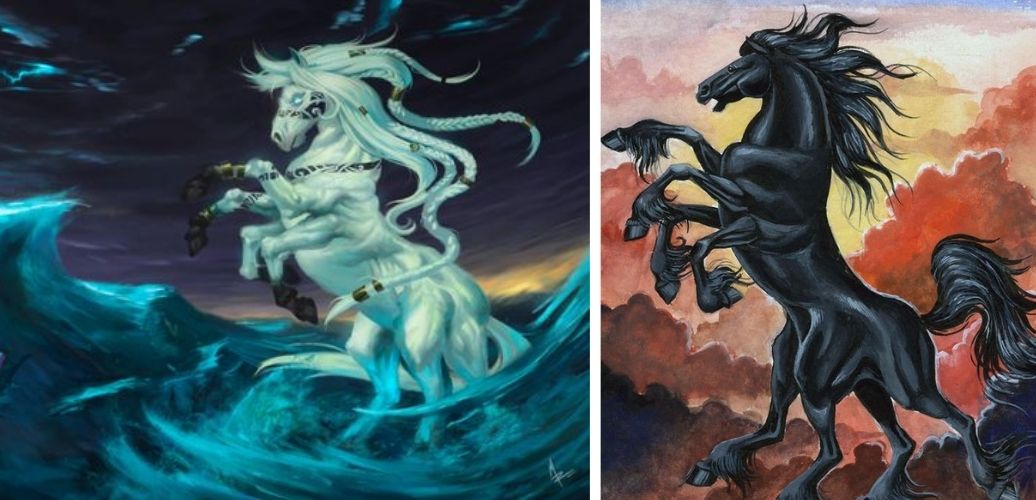
Sleipnir is an eight-legged horse, probably the most famous horse in Norse mythology, which belonged to Odin. It is incredibly fast and can move on water, air and land.
It was conceived when Loki turned into amare to sabotage the construction of the walls surrounding Asgard, by seducing Svaðilfari, a stallion of the giant who built the wall. This makes Sleipnir the brother of Fenrir the Wolf, and Jörmungandr, the World Serpent.
Archaeological findings show that many ancient (pre-Viking) civilizations, from Korea to northwestern Europe, used eight-legged horse symbols. This symbol was used to describe the passage of a soul from life to the afterlife.
For the Vikings, on the other hand, the Sleipnir symbol had more meanings. It was used as a sign ofspeed, luck for travellers and transcendence. It was a favourite symbol for travellers and those seeking spiritual enlightenment.
And Perhaps you will like this music about Sleipnir
THOSE CORBELS OF ODIN
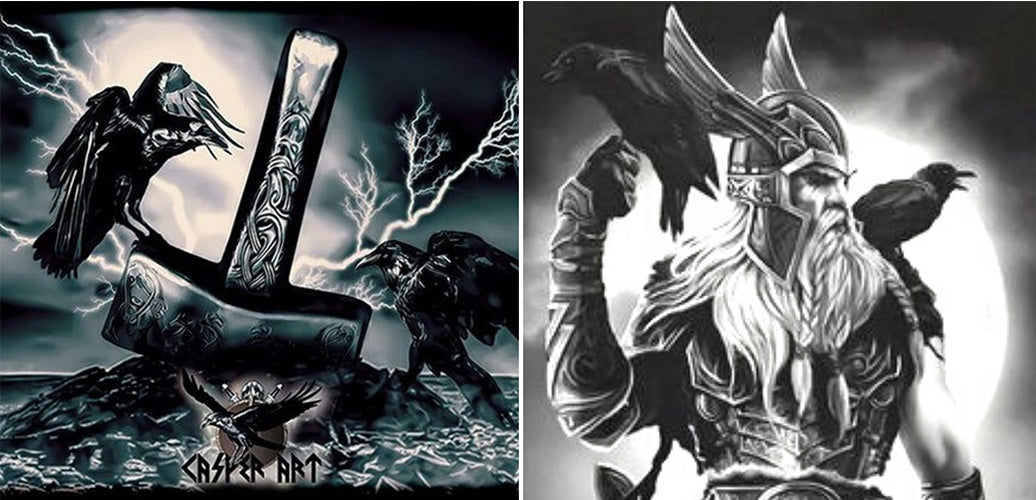
Among the animals most often associated with Vikings, the crow deserves its place on our list. If you're wondering why ravens were so popular with the Vikings, here's the answer:
Odin hadtwo ravens called Muninn (meaning "memory") and Huginn (meaning "thought"). They only left him to fly around the nine realms and gather information which they then whispered in Odin's ear. The importance of ravens in Nordic culture is illustrated by the way Odin is usually depicted. Very often you will come across a work of art depicting Odin with his two ravens sitting on his shoulders.

Another reason for the popularity of the raven symbol is a Viking whose popularity has increased in our time thanks to the TV series Vikings. He lived in the ninth century and claimed to be a descendant of Odin himself. His name was Ragnar Lothbrok. Ragnar's armies used raven banners and were never defeated under them.
Countless myths tell of Ragnar's adventures across Europe. Wherever he went, his raven banner followed him. After Ragnar's death, his sons Ubbe and Ivar used their father's banner to lead the great pagan army to the conquest of England.
The Raven's banner continued to bring victories until 1066. It was then that Harald Hardrada, also known as the "last Viking", lost his last battle, thus ending the Viking Age.
As for the meaning of this symbol to the Vikings, it was used to represent Odin, wisdom, intelligence, perspicacity and glory in battle. Today, however, it is used to symbolise the two centuries of domination and exploration achieved by the Vikings.
NORDIAN SYMBOLS OF THE FYLGJA
Nordic mythology and art have taught us that many gods had their spiritual animal friends, called fylgja. For example, Odin had ravens, Heimdall had rams, Thor had goats, etc.
As for boars, two Norse gods had them as fylgja. These were Freya and her brother Freyr. Freya's fellow warrior was a boar called Hildisvini (meaning "fighting pig"), while Freyr's boar is called Gullinbursti (meaning "golden hair").
The symbol of the boar stood for happiness, peace and abundance for the Vikings.
In addition to having a boar for her fylgja, the goddess Freya also had black or grey cats that pulled her chariot on her travels. Some historians believe that Freya's power to make cats work together was a sign offemale influence (a key topic in Norse culture).
For the Vikings, the symbol of the cat was a sign of blessing, or the character of Freya with all her virtues, such as magic and wisdom, abundance and beauty, love and desire, etc.
Bear - BERSERKERS SYMBOL
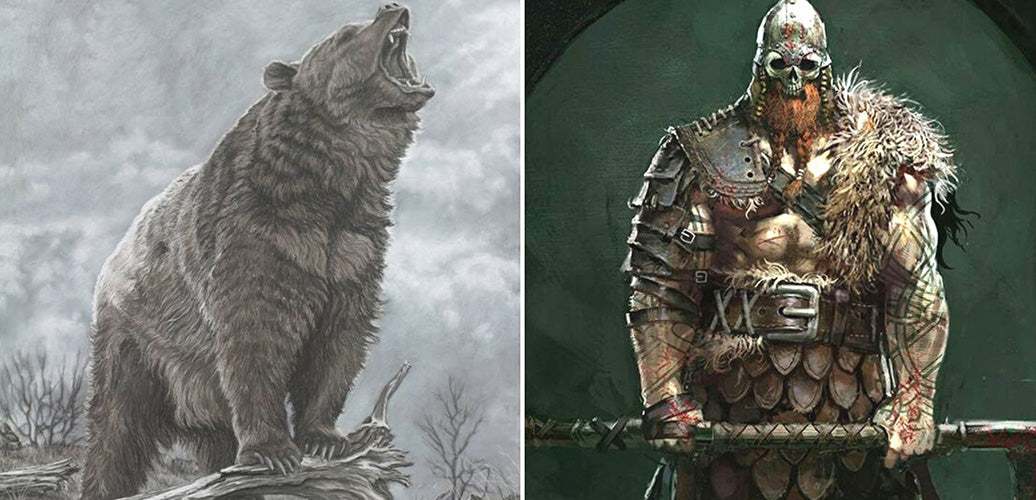
There are few things Vikings fear, and bears are one of them. As one of the strongest and fiercest animals, bears would make even the bravest Viking back down. They are super strong, deadly and massive, with fur capable of withstanding almost any weapon of the time.
As Vikings always tried to bend nature to their will, it is not surprising that some Viking kings hadbears as pets. The Vikings who settled in Greenland even ended up exporting bear furs and even polar bears all over Europe to anyone who had enough money to pay for their goods.
Another connection with bears comes from the berserkers. These were Viking warriors who fought in a state of ecstatic fury and frenzy. Berserkers often fought in front of the shield wall, to inspire their allies and terrify their enemies with their bravery.
The word berserker derives from Old Norse words meaning "bear skin" or "bear shirt". This only strengthens the written evidence suggesting that berserkers entered battle wearing bear armour or without any kind of armour. Either way, the berserkers were undoubtedly warriors who made a difference on the battlefield.
The bear symbol therefore represented incredible strength, fury, courage and thewarrior spirit. Now it's pretty easy to understand why the Scandinavians were fascinated by bears, isn't it!
WOLF SYMBOL - FENRING THE GIANT WOLF
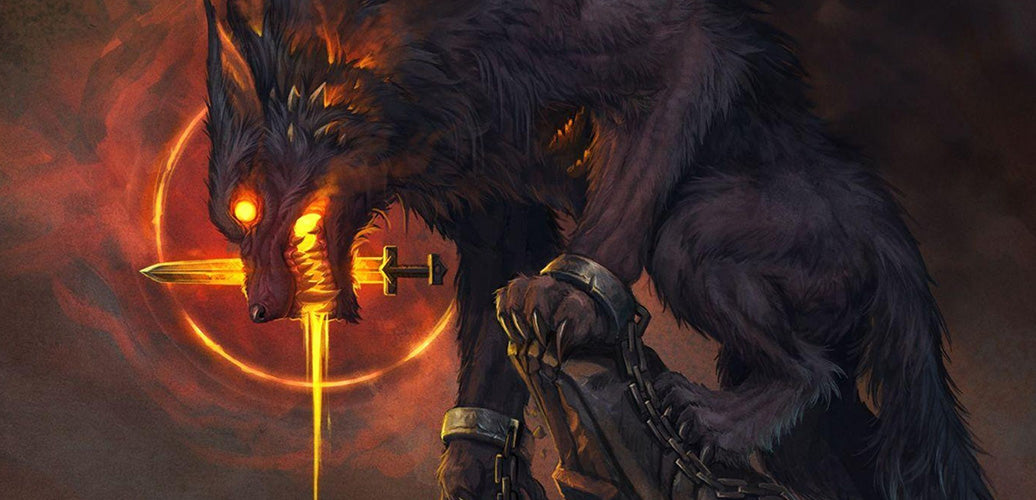
The wolf symbol has contradictory meanings in Norse mythology. It can symbolise both thebest and the worst in people. For example, the symbol can be a sign of teamwork and bravery or a sign of the wrath of nature, the power that even the gods of Asgard could not fight against.
What is the reason for these conflicting meanings? Let's see...
There are some important wolves in Norse folklore. The most famous is undoubtedly Fenrir, the wolf who was so powerful that even the Gods were afraid of him and so decided to imprison him (these attempts resulted in many complications). However, it was predicted that Fenrir would break free of his magical bonds at the beginning of Ragnarok. The wolf will wreak havoc on the world, eventually devouring the sun and moon, and even Odin himself.
Now, you probably understand the "worst of the people" part of this symbol's meaning. Now let's look at the other side of its meaning (the "best of people" part):
Two other wolves play an important role in Norse mythology. They are not as evil as Fenrir, and they accompany Odin, the father of fathers, on his adventures. Their names are Geri and Freki.
In addition to its direct connection to animals, the wolf symbol is also linked to the Viking warriors known as úlfheðnar (meaning "wolf's skin"). It is unclear whether úlfheðnar was a synonym for berserkers or a different type of Viking warrior altogether. Some sources suggest that úlfheðnar fought in small packs, unlike berserkers who fought alone in front of the shield wall. We will never know for sure.
However, one thing is certain. Thewolves were of the utmost importance to Odin, and Viking warriors believed they could channel the power of this symbol, which gave them strength and courage in the battles to come.
DRAGONS - NORDIC SYMBOL OF GREATNESS

Nordic mythology has many myths involving dragons and giant snakes. Even Viking longships are known as "dragon ships", which is a testament to the importance of dragons in Norse culture.
However, let's pause for a moment to explain what the word "dragon" meant to the Vikings. To the Vikings, dragons were far from the dragons we imagine today (the giant, terrifying beasts with broad wings that breathe fire and wreak destruction). Most dragons were more likesnakes, and only a few had wings and the ability to breathe fire.
On the other hand, some dragons in Norse mythology were more than just terrifying monsters. They were themselves cosmic forces. One such creature was Níðhöggr (which means "curse smiter"). He resides at the roots ofthe World Tree, waiting for the Ragnarok to begin.
Another great "dragon" of the Norse universe is Jörmungandr, the World Serpent. Its body is so large that it can encircle the entire world and bite its own tail. Forming a very famous symbol also "the Ouroboros" representing a snake or dragon biting its own tail. A symbol of infinity and the eternal beginning.
Thankfully for Viking heroes like Beowulf and Ragnar Lothbrok, not all dragons were as big as Jörmungandr, as many myths tell of Viking battles with different dragons.
Finally, we must mention one of the most intriguing dragons in Norse mythology, Fáfnir. Fáfnir was a dwarf who turned into a dragon because of his treachery and greed. He sleeps on a vast golden horde and is considered one of the most intelligent and powerful dragons in the Norse universe.
So what is the meaning of the dragon symbol?
This symbol represents greatness in many forms. Great strength, great danger, great destruction and great wealth are some of the things the dragon symbol represents.
FINISH
Today we have tried to explain the meaning of the most popular symbols in Norse mythology. However, don't forget that there were countless others at the time. This is not surprising, given that these symbols were as important to the Vikings as religious iconography is to us today.
The Scandinavians sincerely believed that symbols had magical powers that could help them overcome any obstacle on their life path. The importance of these symbols in Viking times is best illustrated by the countless finds of various Norse symbols in pre-Christian Scandinavia.
To tell the truth, I really envy the Vikings. It must have been great to believe that wearing a special amulet could help you win battles, find the right path when you were lost at sea, increase your strength, protect your loved one and solve any other problem you encountered.
Thank you for reading, it's a pleasure to write for Odin's Hall, the leading brand in accessories from Norse mythology.
I'll let you visit our online shop, maybe you'll find a piece of jewellery or a viking garment that will catch your eye!
SKOL!!
Get into your drakkar and browse our site:


